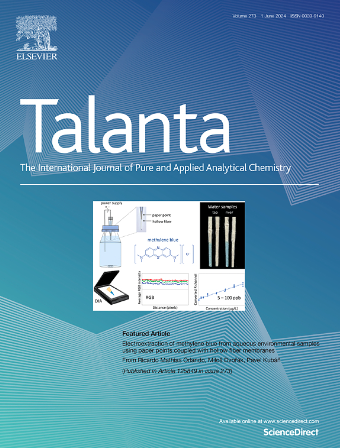基于MoS2量子点/TiO2 NRs光电传感的痕量铅(II)离子高选择性检测
IF 5.6
1区 化学
Q1 CHEMISTRY, ANALYTICAL
引用次数: 0
摘要
MoS2量子点/TiO2纳米棒(MQDs/TNRs)是一种用于痕量Pb2+检测的光电电化学(PEC)平台。高光电流密度是通过Pb2+在MoS2导带最小值附近诱导形成带尾态和缓解MQDs/TNRs p-n结的悬崖状带排列来实现的。在Pb2+、Li+、Na+、K+、Co2+、Cu2+、Zn2+、Ni2+、Cd2+、Fe3+、Mn3+等阳离子中,Pb2+表现出最高的选择性,因为Pb2+在MoS2的S边位的吸附能最低,约为- 1.119 eV。在1 μM - 1000 μM的浓度范围内,光电流密度的相对增加量与Pb2+浓度的对数呈显著的线性关系,检测限低至48 nM。另外,自来水样品在浓度为20 μm和200 μm时,Pb2+的回收率分别为97.95%和96.81%。该传感器为环境治理和水处理中的痕量铅离子检测提供了快速稳定的响应。本文章由计算机程序翻译,如有差异,请以英文原文为准。

Highly selective detection of trace Lead(II) ions based on MoS2 QDs/TiO2 NRs photoelectrochemical sensing
MoS2 quantum dots/TiO2 nanorods (MQDs/TNRs) is designed as a photoelectrochemical (PEC) platform for trace Pb2+ detection. High photocurrent density is achieved by means of Pb2+ induced formation of the band-tail states near the conduction band minimum of MoS2 and relieved cliff-like band alignment of the MQDs/TNRs p-n junctions. Among the cations of Pb2+, Li+, Na+, K+, Co2+, Cu2+, Zn2+, Ni2+, Cd2+, Fe3+, Mn3+, Pb2+ shows the highest selectivity due to the lowest adsorption energy of Pb2+ about −1.119 eV at the edge S sites of MoS2. Between the relative increase in the photocurrent density and the logarithm of Pb2+ concentration there are outstanding linear relationships in the concentration range of 1 μM–1000 μM, with a low detection limit of 48 nM. In addition, high recoveries of Pb2+ are realized at the concentrations of 20 μm for 97.95 % and 200 μm for 96.81 % in the sample analysis of tap water. This sensor offers a fast and stable response for trace lead ions detection in environmental governance and water treatment.
求助全文
通过发布文献求助,成功后即可免费获取论文全文。
去求助
来源期刊

Talanta
化学-分析化学
CiteScore
12.30
自引率
4.90%
发文量
861
审稿时长
29 days
期刊介绍:
Talanta provides a forum for the publication of original research papers, short communications, and critical reviews in all branches of pure and applied analytical chemistry. Papers are evaluated based on established guidelines, including the fundamental nature of the study, scientific novelty, substantial improvement or advantage over existing technology or methods, and demonstrated analytical applicability. Original research papers on fundamental studies, and on novel sensor and instrumentation developments, are encouraged. Novel or improved applications in areas such as clinical and biological chemistry, environmental analysis, geochemistry, materials science and engineering, and analytical platforms for omics development are welcome.
Analytical performance of methods should be determined, including interference and matrix effects, and methods should be validated by comparison with a standard method, or analysis of a certified reference material. Simple spiking recoveries may not be sufficient. The developed method should especially comprise information on selectivity, sensitivity, detection limits, accuracy, and reliability. However, applying official validation or robustness studies to a routine method or technique does not necessarily constitute novelty. Proper statistical treatment of the data should be provided. Relevant literature should be cited, including related publications by the authors, and authors should discuss how their proposed methodology compares with previously reported methods.
 求助内容:
求助内容: 应助结果提醒方式:
应助结果提醒方式:


